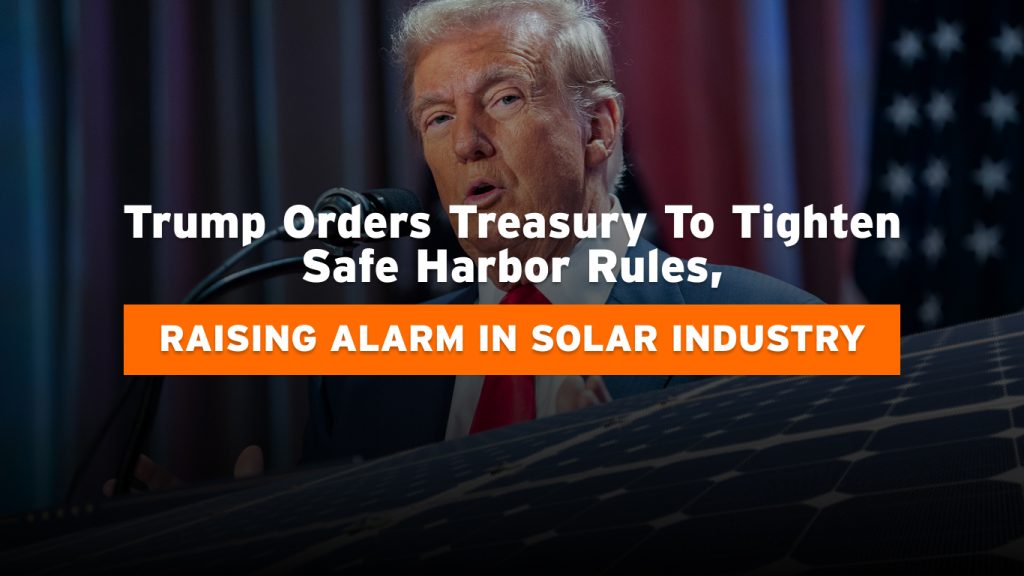President Trump signed an executive order directing the Treasury Department to revise guidelines associated with ‘safe harbor’ rules for clean energy tax credits, according to Solar Power World. The order arrives just days after the signing of the “One Big Beautiful Bill” on July 4 and tightens definitions of what constitutes the start of construction for solar and wind projects, introducing increased uncertainty for renewable developers.
What Are ‘Safe Harbor’ Rules and Why They Matter
Safe harbor rules allow developers to lock in the current versions of clean energy tax credits—such as the solar investment tax credit (48E) or wind production tax credit (45Y)—by either spending at least 5 percent of total project costs upfront or completing major physical construction (Source: Wall Street Journal). These rules provide critical certainty for long-term investments.
The new executive order instructs the Treasury to issue guidance within 45 days to prevent “artificial acceleration or manipulation” of credit eligibility. It also aims to limit broad usage of safe harbor provisions unless a substantial portion of a project has been physically built (Source: The Washington Post, Utility Dive).
Industry Response: Confusion and Concern
Industry stakeholders expressed concerns that the order may disrupt project timelines and financing structures. Brian Dunn, president of Summit Ridge Energy, warned that tightening rules could be “catastrophic for the industry and the country” (Source: Wall Street Journal), particularly as clean energy projects support critical infrastructure like AI-powered data centers.
Frank Getman of Great Bay Renewables said enforcement of tougher rules without clarity from Treasury will introduce “renewed uncertainty” into planning and capital flows (Source: Wall Street Journal).
Some voices, including Doug Kimmelman from Energy Capital Partners, view the order as a motivator for projects to begin actual construction promptly, preventing exploitation of the safe harbor simply by minimal activity (Source: Wall Street Journal).
Broader Market Impact
The directive coincides with wider rollback of renewable incentives in the recently passed spending bill, which ended full tax credits after 2027 for projects not started by mid-2026 (Source: Utility Dive). Large-scale solar and wind financing relies heavily on these credits, so any additional obstacles may cause delays, increased costs or cancellations.
Market reaction was swift: shares of solar-focused companies such as First Solar, Array Technologies, and SolarEdge dropped following the announcement (Source: Investors).
What Developers and Investors Should Know
Solar Power World recommends that developers reassess project timelines and funding structures based on stricter interpretations of beginning-of-construction definitions and safe harbor conditions .
Analysts caution that new guidance may also affect creditability of foreign involvement. Projects with substantial foreign ownership could be disqualified under enhanced “Foreign Entity of Concern” provisions (Source: Thomson Reuters Tax).
Next Steps: Treasury Guidance
The Treasury Department and Interior Department have a 45-day deadline to provide updated guidance and rules related to safe harbor, beginning-of-construction benchmarks, and Foreign Entity of Concern protocols (Source: The White House). Developers will await these final rules before confirming eligibility.
Strategic Balancing Act Ahead
This executive directive reflects a growing tension between securing taxpayer dollars and ensuring rapid deployment of renewables. While proponents argue it prevents misuse of tax credits, detractors caution it undermines investor confidence during a transitional energy period.
As Solar Power World underscores, balancing enforcement with predictability is essential to maintaining clean energy growth. The complexity of new rules may throttle momentum unless policymakers provide timely and transparent guidance.
Bottom Line
President Trump’s executive order raises the bar for demonstrating “beginning of construction” and strengthens oversight on clean energy credits. Solar Power World says this risks slowing project development and freezing investment unless the Treasury offers clear, balanced guidance. The final language will determine whether the clean energy transition advances or stumbles.




